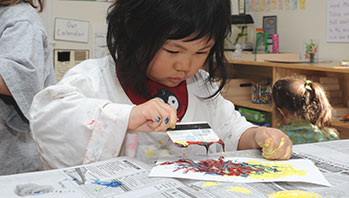- green pipe cleaners
- plastic flowerpots
- scissors, sticky labels
- tissue paper in assorted colors
- blossom
- flower
- squeeze
- stem
- top
- twist
MA Standards:
English Language Arts/Speaking and Listening/SL.PK.MA.5 Create representations of experiences or stories (e.g., drawings, constructions with blocks or other materials, clay models) and explain them to others.
Head Start Outcomes:
Approaches to Learning/Initiative and Curiosity Demonstrates flexibility, imagination, and inventiveness in approaching tasks and activities.
PreK Learning Guidelines:
Science and Technology/Physical Sciences 20 Create representations of experiences or stories (e.g., drawings, constructions with blocks or other materials, clay models) and explain them to others.
Tissue Paper Flower Garden

© Commonwealth of Massachusetts, Department of Early Education and Care (Jennifer Waddell photographer). All rights reserved.
Skill Focus: Creative Expression, Fine Motor Skills, Vocabulary
Educator Prep: Cut the tissue paper into six-inch squares.
Tell children they are going to create a tissue paper garden. Model how to make a flower.
- Select four squares in any color combination. Lay each square so that it is turned 45º from the square below it (if the first is a square, the next should be a diamond, and so on—the top piece of tissue paper will be the center of the flower).
- Place a finger in the center of the squares and gather the sides of the paper around your finger.
- With your free hand, pinch the bottom of the squares together and gather them together.
- Remove your finger and wrap a pipe cleaner securely around the base of the flower, creating a stem.
- You will need to help children create their own flowers. Once a flower is complete, wrap a sticky label with the child’s name on it to the bottom of the stem.
- Allow children to use the flowerpots to create a classroom garden or to use them in the flower shop at the Pretend and Play Center.
Adaptation: If you have very young children in the group, you may wish to do the activity with them one-on-one and help them form the flower.
Adaptation: You may want to pair older children with younger children to help them form the flowers.
